In the spring of 1889, a hopeful group of job seekers wanting to join the Atlanta, Georgia, police force waited to be inspected by the Police Board of Commissioners. The men were marched into the room in two squads, and in the second group was a man who immediately caught the attention of the board. A reporter who was covering the meeting wrote this account:
“In the second squad was a gentleman with but one arm. He gave his name as H.K.W. Childers. ‘How did you lose that arm?’ he was asked. ‘In the second days fight of the seven days fighting around Richmond,’ he answered. ‘ ‘What command?’ ‘Nineteenth Mississippi.’ After the second squad had been retired, there was a general expression of sympathy for the veteran. ‘I wish I could vote for him,’ said the chairman. ‘So do I,’ said Mr. Brown.”
The soldier in question was named Harrison K.W. Childress, but in the grammatically flexible 19th century, he often spelled his name Childers. Sympathy he got from the Board of Commissioners, but little else; there was no room on the Atlanta Police force for a one-armed veteran.
Harrison K.W. Childress was just one of the approximately 78,000 Mississippians who served in the Confederate army during the Civil War. He left no diary or letters about his wartime service that have survived to the present day, and if I had not found this brief article in the March 31, 1889, edition of The Atlanta Constitution, his story, like those of so many other Mississippians, would be lost to history.
But this little tidbit, this one brief article, only gives us a quick glimpse into the life of a disabled Confederate soldier who was struggling to support himself and his family in the postwar South. If only the rest of his story could be told… and fortunately it can. I was intrigued enough by the story of Private Childress to do a little looking, in the off chance that there might be more to his story – and there is! I plugged his name into the search engine at newsinhistory.com, a newspaper archive site that I have a subscription to, and I found a second, more detailed article about Childress written in the April 1, 1906 edition of The Atlanta Constitution.
Before I go into this second article, however, a little background on Harrison K.W. Childress is needed. He was born on May 9, 1838, in Mississippi, probably in Marshall County, which is where the Childress family was recorded as living in the 1850 United States Census. Harrison’s father, Gowen Childress, was a small farmer who reported to the census taker that he owned $1,200 in real estate. By the time of the 1860 census, 21-year-old Harrison and his older brother George were living with a Betsey Waldrip, perhaps as boarders, in Tyro, Marshall County, Mississippi. Harrison listed his occupation as laborer, and reported that he had a personal estate worth $200.00.
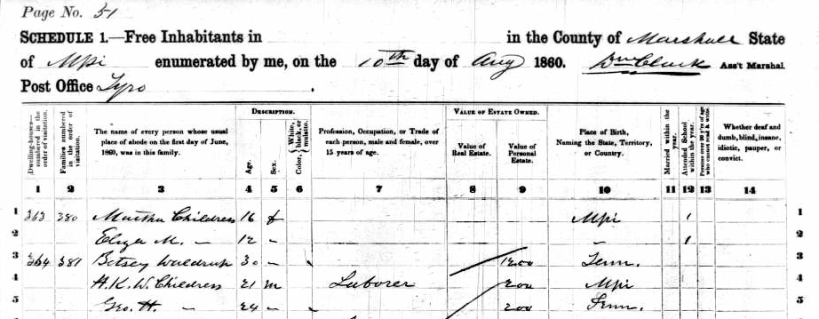
When the Civil War started, Childress joined the “Marshall Rifles” from Marshall County, on May 25, 1861. The company went to Richmond, Virginia, where they were called into the service of the Confederate States as Company I of the 19th Mississippi Infantry.
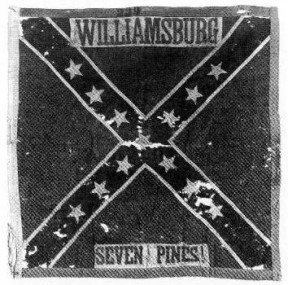
Childress survived the 19th Mississippi’s baptism of fire at the battle of Williamsburg, Virginia, on May 5, 1862, and made it through the regiment’s second battle at Seven Pines, Virginia, on May 31 – June 1, 1862. But Childress’ luck ran out in his third battle, at Gaines’ Mill, Virginia, on June 27, 1862. The 19th Mississippi was part of General Winfield Scott Featherston’s brigade, (12th, 16th, 19th Mississippi regiments and 2nd Mississippi battalion) of General James Longstreet’s corps. Featherston’s brigade was engaged in very heavy fighting at Gaines’ Mill, and the 19th Mississippi in particular took extremely heavy casualties in forcing the Union troops out of their prepared positions. A newspaper reporter for the Macon Telegraph (Macon, GA) wrote on July 4, 1862 of the attack at Gaines’ Mill: “The attack of our men on this position was impetuous and daring, but the loss was great, for the foe were so screened by their position that it was impossible to get at them properly. Their loss was severe…The 19th Mississippi went into action with 521, had 31 killed, 150 wounded.”
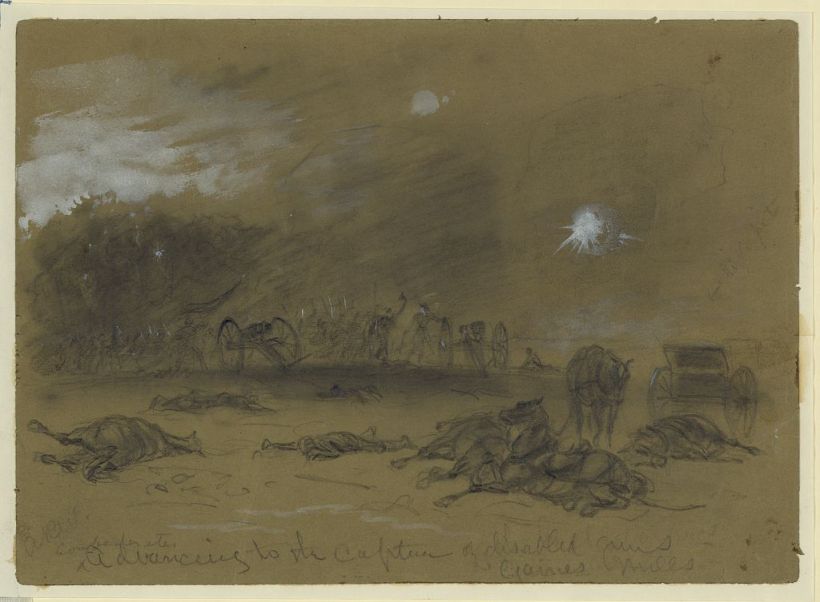
In the bloody fighting at Gaines’ Mill, Childress was hit by a bullet in the left arm, and a Confederate surgeon had to remove the limb above the elbow to save the desperately wounded private’s life. Childress was sent to St. Charles Hospital in Richmond where he slowly recovered from his devastating wound. On August 6, 1862, his service record notes that he was returned to duty. Given the nature of his wounds, Childress doubtless could have asked for, and would have received, a discharge from the army. But the young man did not do that – he remained in uniform, and his service record for January – February 1863 showed that he was “detailed for hospital duties.”
Childress’s wound must have been giving him trouble, for on February 20, 1863, he was admitted to Winder Hospital in Richmond for treatment. His condition made it impossible for him to return to the 19th Mississippi, and on April 23, 1863, he was transferred to an army hospital near his home in Grenada, Mississippi. Again, Childress would have been perfectly justified in seeking a discharge from the army. He had suffered a terrible disfiguring wound in service of the Confederacy, and no one would have thought the worse of him for wanting to go home. But this young man decided to continue to serve his state as best he could. His records for July – August 1864 noted that he

was “Detailed as Hospital Guard in Mississippi.” The final notation in Childress’ service record noted in January 1865 he was on a 30 day furlough, and that the recommendation that his furlough be extended was approved.
After the war Childress returned home to Marshall County to begin a new life. In the 1870 census he listed his occupation as farmer, but it must have been a modest operation: he listed the value of the real estate he owned at $640, and his personal estate was worth $560. In 1873 Childress married Martha Bell, and in 1880 the couple decided to move to Georgia with their four children, settling on a farm in the town of Douglas. The family remained there until sometime in the mid to late 1880s, when they gave up the farm and moved to the city of Atlanta. In 1887 Martha died, and two years later Harrison Childress applied to the state of Georgia for a Confederate veteran’s pension. His application was approved, and the old soldier was granted a pension of $100 per year. This amount, generous as it was, could not sustain his family, and in the 1890 Atlanta city directory, Childress was listed as making his living as a peddler.
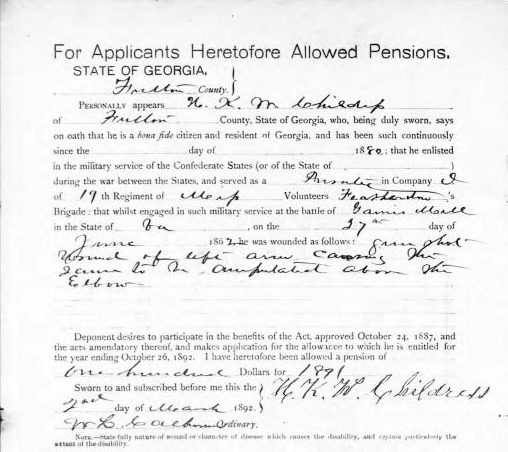
In 1891, the widower married Mary Julia Gay, and about 1905 the couple purchased a house at 299 Jones Avenue in Atlanta. With only modest means, they put down $25 on the $900 house, and paid notes of $10 per month. Even this small amount must have strained the family finances to the limit, for in April 1906, a dejected Harrison Childress walked into the offices of The Atlanta Constitution and related to reporter Alan Rogers his sad story. The newspaperman took down the tale that the old veteran told him, and on April 1, 1906, he published the following article:
VETERAN FIGHTING BATTLE TO SAVE HIS THREE COWS
Struggle of a One-Armed Soldier to Meet the Payment of a $10 Note Which He Must Pay Monday Morning
This is the true story of a battle for three cows and the home of H. K. W. Childress, and the victory seems to lie mostly with the public and the loss of the battle with the 1st of April, when a note for $10 comes due.
H. K. W. Childress, one of the old veterans who was among the first to answer the call of the confederacy, marched in to the office of The Atlanta Constitution yesterday with a story of his last and hardest fight which occurred in a commonplace prosaic battle field on a street in Atlanta in this present time of piping peace.
Comrade Childress for almost a year has been fighting the fight of a brave man, and the cause for which he fought has been the saving of his three cows, which represent the saving of a lifetime. Not a very large capital, perhaps, but there came a time in that other struggle when the Nineteenth Mississippi, C.S.A., was ordered to a charge at Gaines’ Mill, Va. Colonel L. Q. C. Lamar commanded the regiment, and the corps was commanded by Longstreet. To those who know, that tells the whole story, so far as the charge was concerned, although it does not suggest such details as the loss of an arm on the part of Private Childress of Company I, one of the fighting men of the line.
The loss of that army mustered Private Childress out of the army, all soldiers being expected to carry two arms of their own in addition to all ordnance in the way of fighting machinery. But when Private Childress had gone to his old home in Marshall county, Mississippi, and had recuperated at least part of his old-time strength, one of his arms having been buried with a miscellaneous collection of confederate limbs and other members of the body at the field hospital dump behind the old church at Gaines’ Mill this same old soldier reported for duty and the cause he loved at the nearest army hospital as an orderly. He trotted around through the wards, being fortunate in having saving both of his pair of legs while fighting as one of Longstreet’s corps in Virginia, and helped in the dressing of surgical cases as much as a one-armed man could. This was all very well until the surgeons left the hospital and took the field, and then it was found that the requirements were more than any one-armed orderly could meet, and Private Childress was again mustered out and returned to his home in Mississippi.
But all these things are a part of the unwritten history that does not find its way between the covers of handsomely bound covers, where there is no room for the mention of the fighting men of the line, perhaps because there were so many of them. At any rate, it has nothing to do with the battle that was fought in the little barn yard in the rear of 299 Jones avenue, and the hope of saving the three cows that represent the entire assets of the Childress family. Really, this last campaign, this long struggle in the times of peace, began in 1880 when Civilian Childress came to Georgia and rented a farm in the western portion of Fulton County. There were children to raise and educate. These things were attended to. The children grew up, got married and had little troubles of their own. They moved away, and so it is that Mr. Childress is alone with his wife, the only two members of the regiment now waging a gallant fight for saving of the three cows.
It was about a year ago that this Childress regiment of two came to Atlanta. They started to buy the little home at 299 Jones avenue with a payment of $25 down and notes for the remainder at $10 a month until $900 without interest, should be paid. These payments were kept up until now. Then one of the cows went dry. Other complications set in, and now the note is due and the Childress treasury is empty.
Ex-private Childress was far from the fighting man of the ’60’s as he marched into the Constitution office, forty years by the calendar and twice that far because of disabilities that forced themselves in on this one-armed struggle in eking out a living from the rest of the world that hurried by so rapidly that most men with two arms and the full quota of physical members had to double-quick to keep up with the procession. Probably these disabilities were responsible for the hobble rather than the march which with much leaning on a stout cane, made possible his advance to the desk of a reporter. His story was told simply, and his mission was one of information. He wanted to know if there was any way of saving his home, on which he has already paid more than $100, which is a large sum when earned with one arm, and most of all he wanted to know if there was any way in which he could save the cows, which would be little use to him without a place where he and the other member of his little home regiment could milk them.
This note which threatens the loss of the $100, the loss of his home and, most of all, the loss of the three cows which have done so much and which have been such good friends to the Childresses in their struggle against the battles that belong to these piping times of peace.
I wish I could tell you how the story ended – but I simply do not know. I searched the following issues of the paper, but I could not find any mention of Childress. I like to think that someone came forward and helped the old veteran, but that’s just wishful thinking on my part. I am an historian, and I have to stick to the facts. I did find one more piece of information about Childress, however, in the February 8, 1907 edition of The Atlanta Constitution. Listed under the title “MORTUARY,” it simply stated: “H. K. W. Childress, aged 67 years, died yesterday morning at 2 o’clock at the residence of his daughter, Mrs. W. F. Cassells, 80 Belgrade avenue. He was a brave confederate soldier and is survived by his wife, four daughters and three sons.”
Childress may not have been able to leave his family riches of the material sort, but he did pass on to them a rich legacy of honorable service to his country. His son, Albert Wylie Childress, served 30 years in the United States army, retiring as a captain. When he died in 1953 he was buried in Arlington National Cemetery. Albert’s son, Albert Wylie Childress II, attended the United States Military Academy, graduating with the Class of 1945. After a long and honorable career he retired as a lieutenant colonel in the army.
Harrison K. W. Childress is buried in the Ramah Church Cemetery in Palmetto, Georgia.
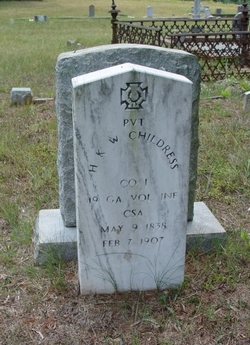
He has both civilian and military markers on his grave, but the marble stone denoting his military service has a mistake: his unit is listed as the 19th Georgia Infantry instead of the 19th Mississippi Infantry. It’s a small thing, but it should be corrected; Childress was a proud son of Mississippi, who fought along side his fellow Mississippians, shed his blood among his fellow Mississippians, and he will always be counted among the Mississippians who served their state so well during the terrible Civil War.

Interesting to me because of the Chilldress name. I then saw the Marshall county connection and realized that my ancestors lived close to Harrison. I had family marry into what is probably a part of his extended family. So had to do more research to learn more about the home and his widow.
1907 Altanta City Directory (issued 1 January 1907; complied after the financial problem, but before his death) shows; CHILDRESS Harry K (Mary). r 299 Jones ave. Still at this address.
1908 Atlanta City Directory shows: CHILDRESS Julia, widow Harris K W, r 552 Sells ave. His widow had moved, but we don’t know why.
1911 Altanta City Directory shows: CHILDRESS M Julia, widow Harris K W, r 184 Sells av. His widow had moved again. Regardless of our research, we always have unanswered questions.
Thanks for your interesting posts.
Marie,
I’m glad you like the article, and thanks for the interesting information on Childress and his family.